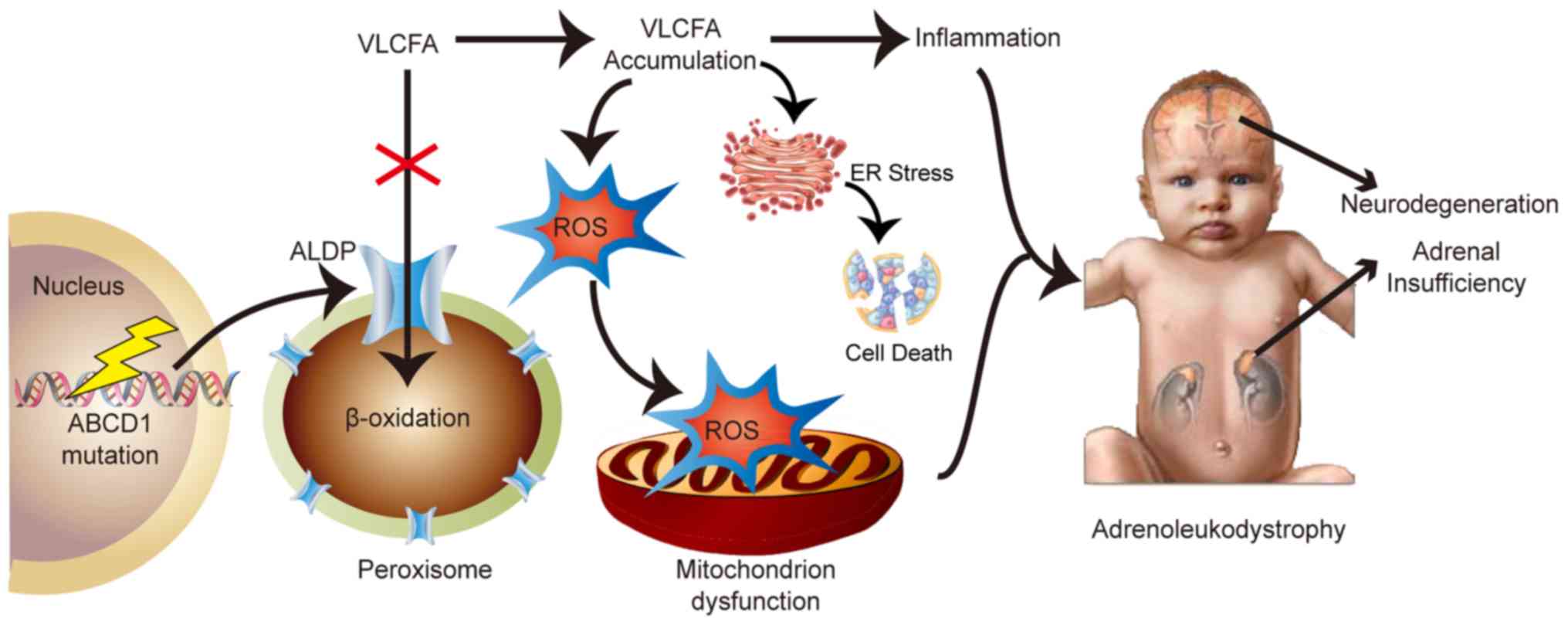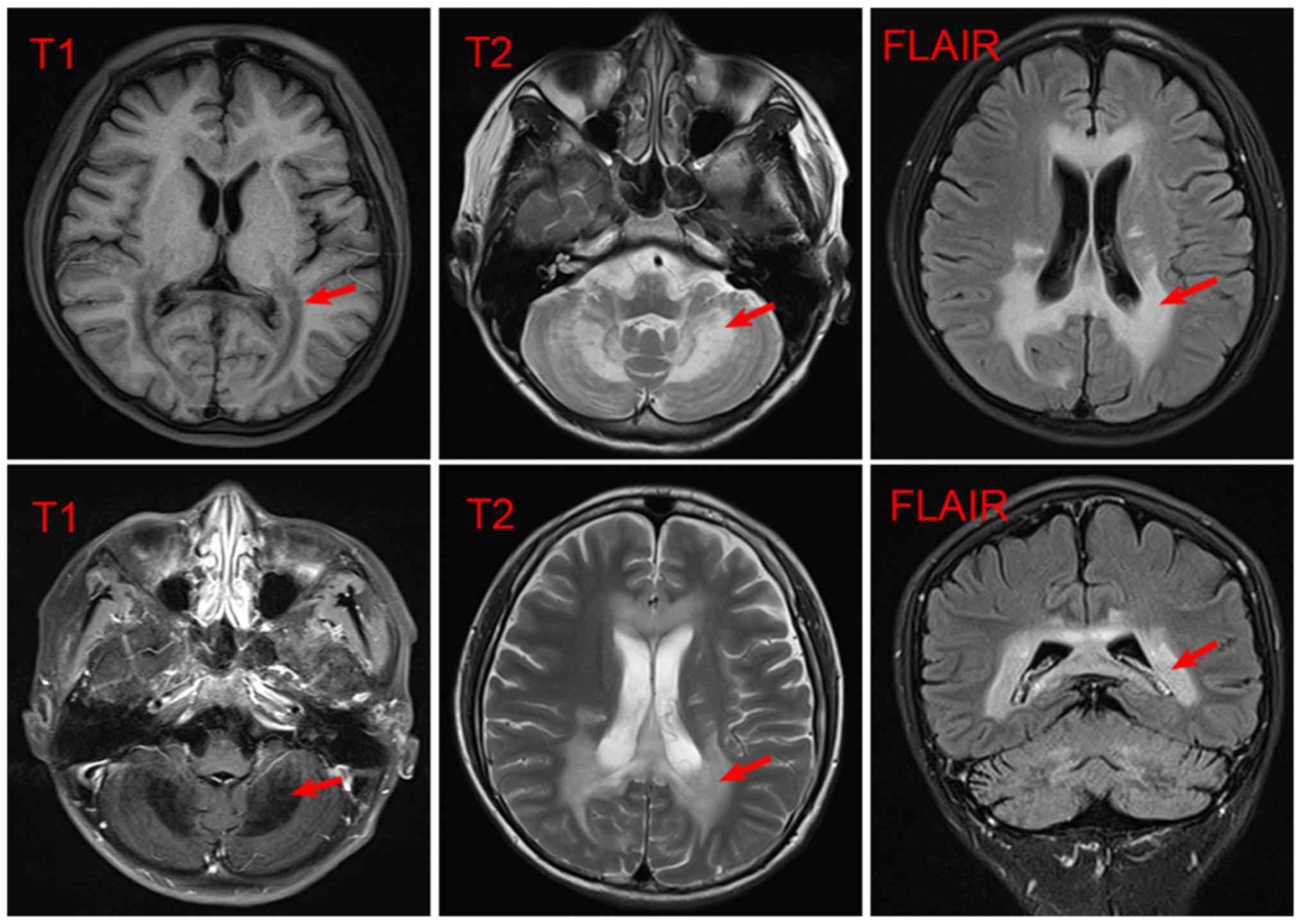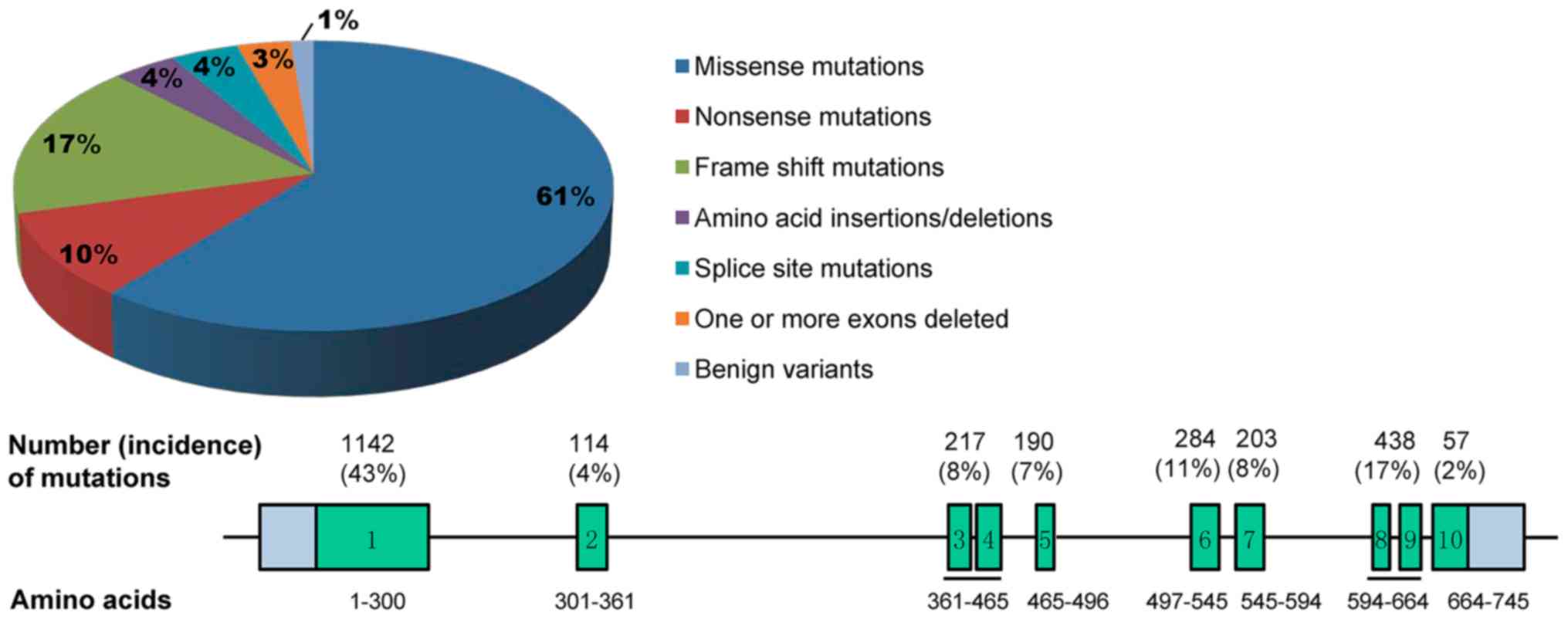|
1
|
Bezman L, Moser AB, Raymond GV, Rinaldo P,
Watkins PA, Smith KD, Kass NE and Moser HW: Adrenoleukodystrophy:
Incidence, new mutation rate, and results of extended family
screening. Ann Neurol. 49:512–517. 2001. View Article : Google Scholar : PubMed/NCBI
|
|
2
|
Kemp S, Berger J and Aubourg P: X-linked
adrenoleukodystrophy: Clinical, metabolic, genetic and
pathophysiological aspects. Biochim Biophys Acta. 1822:1465–1474.
2012. View Article : Google Scholar : PubMed/NCBI
|
|
3
|
Moser HW, Mahmood A and Raymond GV:
X-linked adrenoleukodystrophy. Nat Clin Pract Neurol. 3:140–151.
2007. View Article : Google Scholar : PubMed/NCBI
|
|
4
|
Kemp S, Pujol A, Waterham HR, van Geel BM,
Boehm CD, Raymond GV, Cutting GR, Wanders RJ and Moser HW: ABCD1
mutations and the X-linked adrenoleukodystrophy mutation database:
Role in diagnosis and clinical correlations. Hum Mutat. 18:499–515.
2001. View Article : Google Scholar : PubMed/NCBI
|
|
5
|
Mosser J, Douar AM, Sarde CO, Kioschis P,
Feil R, Moser H, Poustka AM, Mandel JL and Aubourg P: Putative
X-linked adrenoleukodystrophy gene shares unexpected homology with
ABC transporters. Nature. 361:726–730. 1993. View Article : Google Scholar : PubMed/NCBI
|
|
6
|
Boehm CD, Cutting GR, Lachtermacher MB,
Moser HW and Chong SS: Accurate DNA-based diagnostic and carrier
testing for X-linked adrenoleukodystrophy. Mol Genet Metab.
66:128–136. 1999. View Article : Google Scholar : PubMed/NCBI
|
|
7
|
Singh I, Moser HW, Moser AB and Kishimoto
Y: Adrenoleukodystrophy: Impaired oxidation of long chain fatty
acids in cultured skin fibroblasts an adrenal cortex. Biochem
Biophys Res Commun. 102:1223–1229. 1981. View Article : Google Scholar : PubMed/NCBI
|
|
8
|
Pereira Fdos S, Matte U, Habekost CT, de
Castilhos RM, El Husny AS, Lourenco CM, Vianna-Morgante AM,
Giuliani L, Galera MF, Honjo R, et al: Mutations, clinical findings
and survival estimates in South American patients with X-linked
adrenoleukodystrophy. PLoS One. 7:e341952012. View Article : Google Scholar : PubMed/NCBI
|
|
9
|
Dvoráková L, Storkánová G, Unterrainer G,
Hujová J, Kmoch S, Zeman J, Hrebicek M and Berger J: Eight novel
ABCD1 gene mutations and three polymorphisms in patients with
X-linked adrenoleukodystrophy: The first polymorphism causing an
amino acid exchange. Hum Mutat. 18:52–60. 2001. View Article : Google Scholar : PubMed/NCBI
|
|
10
|
Wang Z, Yan A, Lin Y, Xie H, Zhou C and
Lan F: Familial skewed × chromosome inactivation in
adrenoleukodystrophy manifesting heterozygotes from a Chinese
pedigree. PLoS One. 8:e579772013. View Article : Google Scholar : PubMed/NCBI
|
|
11
|
Ping LL, Bao XH, Wang AH, Pan H, Wu Y,
Xiong H, Jiang YW, Qin J and Wu XR: Clinical features and
genotype-phenotype studies of 89 Chinese patients with X-linked
adrenoleukodystrophy. Zhonghua Er Ke Za Zhi. 45:203–207. 2007.(In
Chinese). PubMed/NCBI
|
|
12
|
Ping LL, Bao XH, Wang AH, Pan H, Wu Y,
Xiong H, Zhang YH, Jiang YW, Qin J and Wu XR: The genotype and
phenotype studies of 40 Chinese patients with X-linked
adrenoleukodystrophy (X-ALD). Beijing Da Xue Xue Bao Yi Xue Ban.
38:66–70. 2006.PubMed/NCBI
|
|
13
|
Chu SS, Ye J, Zhang HW, Han LS, Qiu WJ,
Gao XL and Gu XF: Eight novel mutations in the ABCD1 gene and
clinical characteristics of 25 Chinese patients with X-linked
adrenoleukodystrophy. World J Pediatr. 11:366–373. 2015. View Article : Google Scholar : PubMed/NCBI
|
|
14
|
Engelen M, Kemp S, de Visser M, van Geel
BM, Wanders RJ, Aubourg P and Poll-The BT: X-linked
adrenoleukodystrophy (X-ALD): Clinical presentation and guidelines
for diagnosis, follow-up and management. Orphanet J Rare Dis.
7:512012. View Article : Google Scholar : PubMed/NCBI
|
|
15
|
Yan F, Wang W, Ying H, Li H, Chen J and Xu
C: S149R, a novel mutation in the ABCD1 gene causing X-linked
adrenoleukodystrophy. Oncotarget. 8:87529–87538. 2017. View Article : Google Scholar : PubMed/NCBI
|
|
16
|
Eichler F, Duncan C, Musolino PL, Orchard
PJ, De Oliveira S, Thrasher AJ, Armant M, Dansereau C, Lund TC,
Miller WP, et al: Hematopoietic stem-cell gene therapy for cerebral
adrenoleukodystrophy. N Engl J Med. 377:1630–1638. 2017. View Article : Google Scholar : PubMed/NCBI
|
|
17
|
Shimozawa N, Honda A, Kajiwara N, Kozawa
S, Nagase T, Takemoto Y and Suzuki Y: X-linked
adrenoleukodystrophy: Diagnostic and follow-up system in Japan. J
Hum Genet. 56:106–109. 2011. View Article : Google Scholar : PubMed/NCBI
|
|
18
|
Ogaki K, Koga S, Aoki N, Lin W, Suzuki K,
Ross OA and Dickson DW: Adult-onset cerebello-brainstem dominant
form of X-linked adrenoleukodystrophy presenting as multiple system
atrophy: Case report and literature review. Neuropathology.
36:64–76. 2016. View Article : Google Scholar : PubMed/NCBI
|
|
19
|
Li JY, Hsu CC and Tsai CR: Spinocerebellar
variant of adrenoleukodystrophy with a novel ABCD1 gene mutation. J
Neurol Sci. 290:163–165. 2010. View Article : Google Scholar : PubMed/NCBI
|
|
20
|
Jiang MY, Cai YN, Liang CL, Peng MZ, Sheng
HY, Fan LP, Lin RZ, Jiang H, Huang Y and Liu L: Clinical,
biochemical, neuroimaging and molecular findings of X-linked
Adrenoleukodystrophy patients in South China. Metab Brain Dis.
30:1439–1444. 2015. View Article : Google Scholar : PubMed/NCBI
|
|
21
|
Dubey P, Raymond GV, Moser AB, Kharkar S,
Bezman L and Moser HW: Adrenal insufficiency in asymptomatic
adrenoleukodystrophy patients identified by very long-chain fatty
acid screening. J Pediat. 146:528–532. 2005. View Article : Google Scholar : PubMed/NCBI
|
|
22
|
Miyoshi Y, Sakai N, Hamada Y, Tachibana M,
Hasegawa Y, Kiyohara Y, Yamada H, Murakami M, Kondou H, Kimura-Ohba
S, et al: Clinical aspects and adrenal functions in eleven Japanese
children with X-linked adrenoleukodystrophy. Endocr J. 57:965–972.
2010. View Article : Google Scholar : PubMed/NCBI
|
|
23
|
Polgreen LE, Chahla S, Miller W, Rothman
S, Tolar J, Kivisto T, Nascene D, Orchard PJ and Petryk A: Early
diagnosis of cerebral X-linked adrenoleukodystrophy in boys with
Addison's disease improves survival and neurological outcomes. Eur
J Pediatr. 170:1049–1054. 2011. View Article : Google Scholar : PubMed/NCBI
|
|
24
|
Korenke GC, Roth C, Krasemann E, Hüfner M,
Hunneman DH and Hanefeld F: Variability of endocrinological
dysfunction in 55 patients with X-linked adrenoleucodystrophy:
Clinical, laboratory and genetic findings. Eur J Endocrinol.
137:40–47. 1997. View Article : Google Scholar : PubMed/NCBI
|
|
25
|
Jorge P, Quelhas D, Oliveira P, Pinto R
and Nogueira A: X-linked adrenoleukodystrophy in patients with
idiopathic Addison disease. Eur J Pediatr. 153:594–597. 1994.
View Article : Google Scholar : PubMed/NCBI
|
|
26
|
Kemp S, Huffnagel IC, Linthorst GE,
Wanders RJ and Engelen M: Adrenoleukodystrophy-neuroendocrine
pathogenesis and redefinition of natural history. Nat Rev
Endocrinol. 12:606–615. 2016. View Article : Google Scholar : PubMed/NCBI
|
|
27
|
Huffnagel IC, van de Beek MC, Showers AL,
Orsini JJ, Klouwer FCC, Dijkstra IME, Schielen PC, van Lenthe H,
Wanders RJA, Vaz FM, et al: Comparison of C26:0-carnitine and
C26:0-lysophosphatidylcholine as diagnostic markers in dried blood
spots from newborns and patients with adrenoleukodystrophy. Mol
Genet Metab. 122:209–215. 2017. View Article : Google Scholar : PubMed/NCBI
|
|
28
|
Aubourg P, Adamsbaum C, Lavallard-Rousseau
MC, Rocchiccioli F, Cartier N, Jambaqué I, Jakobezak C, Lemaitre A,
Boureau F, Wolf C, et al: A two-year trial of oleic and erucic
acids (‘Lorenzo's oil’) as treatment for adrenomyeloneuropathy. N
Engl J Med. 329:745–752. 1993. View Article : Google Scholar : PubMed/NCBI
|
|
29
|
Miller WP, Rothman SM, Nascene D, Kivisto
T, DeFor TE, Ziegler RS, Eisengart J, Leiser K, Raymond G, Lund TC,
et al: Outcomes after allogeneic hematopoietic cell transplantation
for childhood cerebral adrenoleukodystrophy: The largest
single-institution cohort report. Blood. 118:1971–1978. 2011.
View Article : Google Scholar : PubMed/NCBI
|
|
30
|
Wiesinger C, Eichler FS and Berger J: The
genetic landscape of X-linked adrenoleukodystrophy: Inheritance,
mutations, modifier genes, and diagnosis. Appl Clin Genet.
8:109–121. 2015.PubMed/NCBI
|

















